《英语国家概况》自学教材目录及考试大纲
英语国家概况
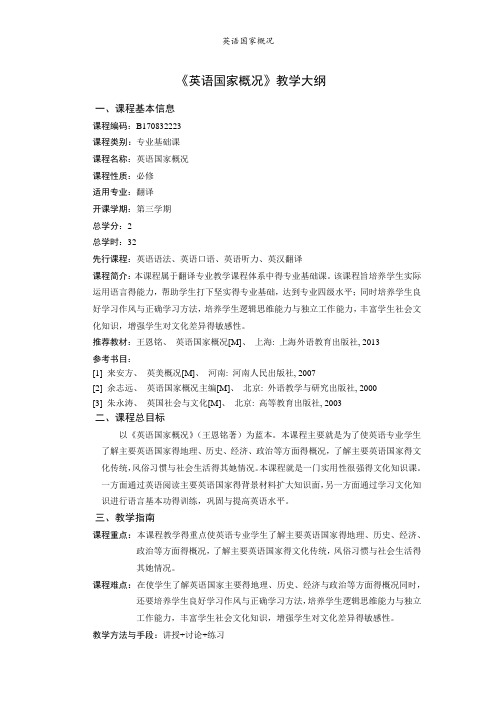
《英语国家概况》教学大纲一、课程基本信息课程编码:B170832223课程类别:专业基础课课程名称:英语国家概况课程性质:必修适用专业:翻译开课学期:第三学期总学分:2总学时:32先行课程:英语语法、英语口语、英语听力、英汉翻译课程简介:本课程属于翻译专业教学课程体系中得专业基础课。
该课程旨培养学生实际运用语言得能力,帮助学生打下坚实得专业基础,达到专业四级水平;同时培养学生良好学习作风与正确学习方法,培养学生逻辑思维能力与独立工作能力,丰富学生社会文化知识,增强学生对文化差异得敏感性。
推荐教材:王恩铭、英语国家概况[M]、上海: 上海外语教育出版社, 2013参考书目:[1] 来安方、英美概况[M]、河南: 河南人民出版社, 2007[2] 余志远、英语国家概况主编[M]、北京: 外语教学与研究出版社, 2000[3] 朱永涛、英国社会与文化[M]、北京: 高等教育出版社, 2003二、课程总目标以《英语国家概况》(王恩铭著)为蓝本。
本课程主要就是为了使英语专业学生了解主要英语国家得地理、历史、经济、政治等方面得概况,了解主要英语国家得文化传统,风俗习惯与社会生活得其她情况。
本课程就是一门实用性很强得文化知识课。
一方面通过英语阅读主要英语国家得背景材料扩大知识面,另一方面通过学习文化知识进行语言基本功得训练,巩固与提高英语水平。
三、教学指南课程重点:本课程教学得重点使英语专业学生了解主要英语国家得地理、历史、经济、政治等方面得概况,了解主要英语国家得文化传统,风俗习惯与社会生活得其她情况。
课程难点:在使学生了解英语国家主要得地理、历史、经济与政治等方面得概况同时,还要培养学生良好学习作风与正确学习方法,培养学生逻辑思维能力与独立工作能力,丰富学生社会文化知识,增强学生对文化差异得敏感性。
教学方法与手段:讲授+讨论+练习四、理论课程教学内容第一章Britain: Land and People教学目得:掌握英国得自然、地理、人口概况。
英语国家概况课程教学大纲
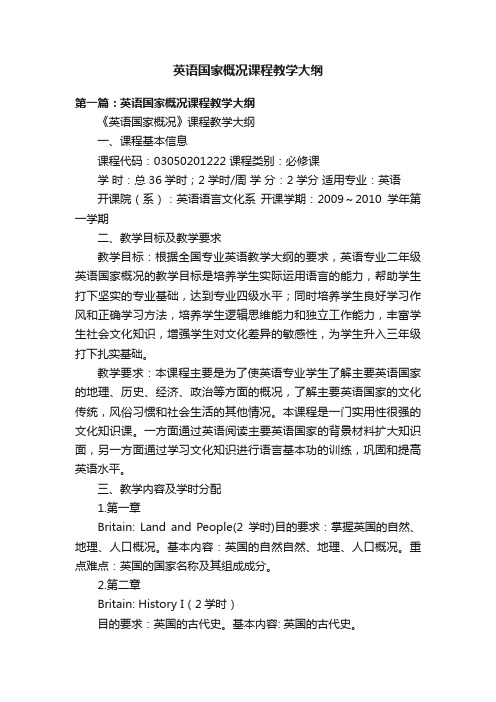
英语国家概况课程教学大纲第一篇:英语国家概况课程教学大纲《英语国家概况》课程教学大纲一、课程基本信息课程代码:03050201222 课程类别:必修课学时:总36学时;2学时/周学分:2学分适用专业:英语开课院(系):英语语言文化系开课学期:2009~2010学年第一学期二、教学目标及教学要求教学目标:根据全国专业英语教学大纲的要求,英语专业二年级英语国家概况的教学目标是培养学生实际运用语言的能力,帮助学生打下坚实的专业基础,达到专业四级水平;同时培养学生良好学习作风和正确学习方法,培养学生逻辑思维能力和独立工作能力,丰富学生社会文化知识,增强学生对文化差异的敏感性,为学生升入三年级打下扎实基础。
教学要求:本课程主要是为了使英语专业学生了解主要英语国家的地理、历史、经济、政治等方面的概况,了解主要英语国家的文化传统,风俗习惯和社会生活的其他情况。
本课程是一门实用性很强的文化知识课。
一方面通过英语阅读主要英语国家的背景材料扩大知识面,另一方面通过学习文化知识进行语言基本功的训练,巩固和提高英语水平。
三、教学内容及学时分配1.第一章Britain: Land and People(2学时)目的要求:掌握英国的自然、地理、人口概况。
基本内容:英国的自然自然、地理、人口概况。
重点难点:英国的国家名称及其组成成分。
2.第二章Britain: History I(2学时)目的要求:英国的古代史。
基本内容: 英国的古代史。
重点难点:英国历史上主要的入侵者,如:盎格鲁·萨克逊人;诺曼征服及其影响。
3.第三章Britain: History II(2学时)目的要求:英国的形成。
基本内容: 英国的形成。
重点难点:英国历史上的大宪章,百年战争,及其黑死病等重要历史事件。
4.第四章Britain: History III(2学时)目的要求:英国的近代史。
基本内容:英国的近代史。
重点难点:英国宗教改革,文艺复兴,英国内战,光荣革命。
英语国家概况考试大纲
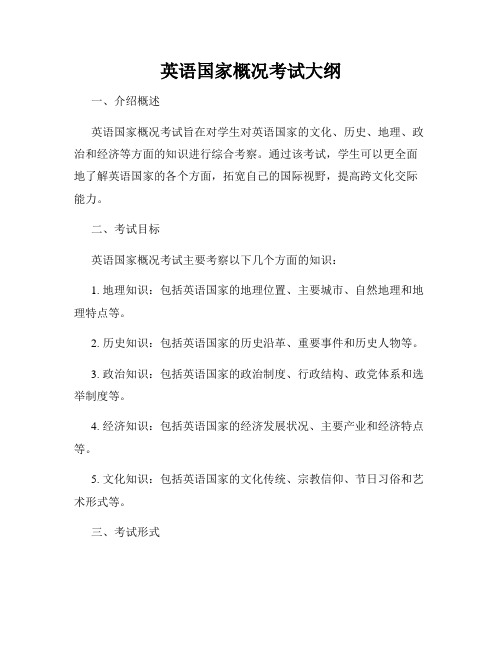
英语国家概况考试大纲一、介绍概述英语国家概况考试旨在对学生对英语国家的文化、历史、地理、政治和经济等方面的知识进行综合考察。
通过该考试,学生可以更全面地了解英语国家的各个方面,拓宽自己的国际视野,提高跨文化交际能力。
二、考试目标英语国家概况考试主要考察以下几个方面的知识:1. 地理知识:包括英语国家的地理位置、主要城市、自然地理和地理特点等。
2. 历史知识:包括英语国家的历史沿革、重要事件和历史人物等。
3. 政治知识:包括英语国家的政治制度、行政结构、政党体系和选举制度等。
4. 经济知识:包括英语国家的经济发展状况、主要产业和经济特点等。
5. 文化知识:包括英语国家的文化传统、宗教信仰、节日习俗和艺术形式等。
三、考试形式英语国家概况考试采用闭卷形式,包括选择题和简答题。
选择题主要考察对基础知识的掌握程度,简答题则要求学生能够对所学知识进行运用和拓展。
四、备考建议1. 充分了解考纲要求:仔细阅读考试大纲,了解各个方面的考察内容和重点。
2. 多途径获取信息:通过阅读相关书籍、报纸、杂志和观看纪录片等多种途径获取所需信息。
3. 制定合理的学习计划:根据考试大纲的要求,制定合理的学习计划,合理分配时间,保证每个方面都有足够的时间进行学习。
4. 做好笔记整理:在学习过程中,及时做好笔记整理,方便复习和回顾。
5. 多练习,提高应试能力:通过做相关练习题,加强对知识点的理解和掌握,提高解题能力和应试能力。
五、考试注意事项1. 仔细审题:在答题之前,要仔细审题,确保理解题意,明确要求,避免解题偏差。
2. 合理安排答题时间:根据题目的分值和难度,合理安排答题时间,避免因时间不够而影响到其他题目的完成。
3. 语言表达准确清晰:在回答简答题时,要注意语言表达的准确性和清晰度,避免出现理解困难或模糊不清的情况。
六、总结通过英语国家概况考试的学习和备考,我们可以更全面地了解英语国家的各个方面知识,拓宽自己的国际视野,提高对跨文化交际的理解和应对能力。
《英语国家概况》自学教材目录及考试大纲
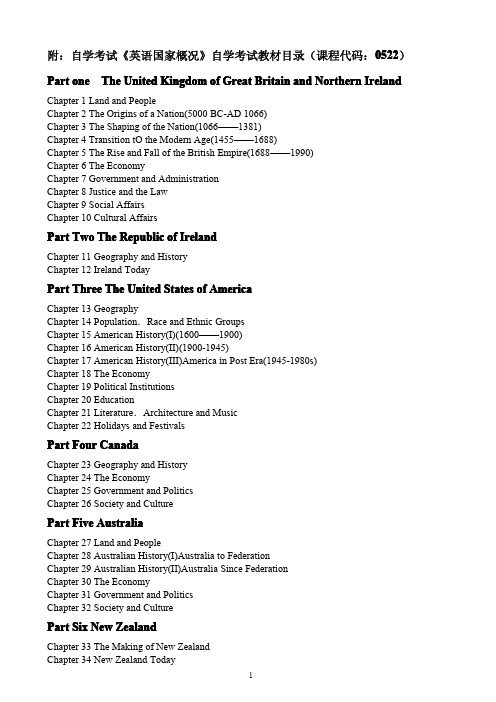
附:自学考试《英语国家概况》自学考试教材目录(课程代码:0522)Part one The United Kingdom of Great Britain and Northern Ireland Chapter1Land and PeopleChapter2The Origins of a Nation(5000BC-AD1066)Chapter3The Shaping of the Nation(1066——1381)Chapter4Transition tO the Modern Age(1455——1688)Chapter5The Rise and Fall of the British Empire(1688——1990)Chapter6The EconomyChapter7Government and AdministrationChapter8Justice and the LawChapter9Social AffairsChapter10Cultural AffairsPart Two The Republic of IrelandChapter11Geography and HistoryChapter12Ireland TodayPart Three The United States of AmericaChapter13GeographyChapter14Population.Race and Ethnic GroupsChapter15American History(I)(1600——1900)Chapter16American History(II)(1900-1945)Chapter17American History(III)America in Post Era(1945-1980s)Chapter18The EconomyChapter19Political InstitutionsChapter20EducationChapter21Literature.Architecture and MusicChapter22Holidays and FestivalsPart Four CanadaChapter23Geography and HistoryChapter24The EconomyChapter25Government and PoliticsChapter26Society and CulturePart Five AustraliaChapter27Land and PeopleChapter28Australian History(I)Australia to FederationChapter29Australian History(II)Australia Since FederationChapter30The EconomyChapter31Government and PoliticsChapter32Society and CulturePart Six New ZealandChapter33The Making of New ZealandChapter34New Zealand Today第一部分英国概况第一章国土和人民第二章英国民族起源(5000BC~AD1066)第三章民族的形成(1066~1381)第四章向现代过渡时期的英国(1455~1688)第五章大英帝国的兴衰(1688~1990)第六章经济第七章英国政府机构第八章法律与司法机构第九章英国社会第十章英国文化第二部分爱尔兰概况第十一章爱尔兰地理与历史第十二章今日爱尔兰第三部分美国概况第十三章美国地理第十四章人口、种族和种族集团第十五章美国历史(I)(1600~1900)第十六章美国历史(II)(1900~1945)第十七章美国历史(III)二次大战后的美国(1945-1980S)第十八章美国经济第十九章政治体制第二十章教育第二十一章文学、建筑和音乐第二十二章假日和节日第四部分加拿大概况第二十三章加拿大地理与历史第二十四章加拿大经济第二十五章加拿大政府与政治第二十六章加拿大的社会与文化第五部分澳大利亚概况第二十七章土地与人民第二十八章澳大利亚联邦成立之前的历史第二十九章澳大利亚联邦成立以来的历史第三十章澳大利亚经济第三十一章澳大利亚政府与政治制度第三十二章澳大利亚社会与文化第六部分新西兰概况第三十三章新西兰地理与历史第三十四章今日新西兰附件:《英语国家概况自学考试大纲》的考核目标Part One The United Kingdom of Great Britain and Northern Ireland Chapter1Land and PeopleI.Different Names for Britain and its PartsChapter2The Origins of a NationI.Early Settlers3.The CeltsII.Roman BritainIII.The Anglo-SaxonsⅣ.The Viking and Danish InvasionsV.The Norman ConquestChapter3The Shaping of the NationⅠ.Norman Rule1.William’s RuleⅡ.The Great Charter and the Beginning of Parliament1.The Great CharterⅢ.The Hundred Years’War with FranceⅣ.The Black Death and the Peasant UprisingChapter4Transition to the Modern AgeⅠ.Transition to the Modern AgeⅡ.The English ReformationⅢ.Elizabeth I1.Elizabeth and Parliament2.Elizabeth’s Religious Reform3.Elizabeth’s Foreign PolicyⅣ.The English RenaissanceVII.The Civil WarsVIII.The CommonwealthIX.The Restoration and the Glorious Revolution of1688Chapter5The Rise and Fall of the British EmpireⅠ.Whigs and ToriesⅡ.Agricultural Changes in the Late18th CenturyⅢ.The Industrial RevolutionⅣ.The Chartist MovementVII.Twentieth Century1.Britain and the First World War3.Britain and the Second World War4.Postwar BritainChapter7Government and AdministrationⅠ.The MonarchyⅡ.Parliament1.The House of Lords2.The House of CommonsⅢ.The Cabinet and MinistryⅣ.The Privy CouncilChapter8Justice and the LawIV.The JudiciaryV.PoliceChapter9Social AffairsⅠ.Health and Social Services1.The National Health ServiceⅢ.Religion1.Established churchesⅣ.Festivals and Public Holidays1.Christian festivals2.Other festivals3.Public holidaysChapter10Cultural AffairsⅠ.Education3.Higher educationⅡ.The Media1.NewspapersⅢ.SportsⅣ.The Arts3.DramaPart Two The Republic of Ireland Chapter11Geography and HistoryI.Geographical FeaturesII.Climate and WeatherIII.Population and ReligionIV.Historical backgroundPart Three The United States of America Chapter14Population,Race and Ethnic GroupsI.IntroductionIV.Racial and Ethnic Minorities1.BlacksChapter15American History(I)Ⅰ.Discovery of the New WorldⅡ.The Colonial PeriodⅢ.The War of IndependenceⅣ.A New Form of GovernmentⅥ.Territorial Expansion and Westward MovementⅦ.The Civil WarⅧ.Rapid Growth of Capitalism after the Civil WarChapter16American History(II)Ⅰ.Economic DevelopmentⅡ.ProgressivismⅢ.World War I and the United StatesⅣ.The United States in the1920sⅤ.The Great Depression and the New DealⅥ.World War II and the United StatesChapter17American History(III)Ⅰ.The Origins of the Cold WarⅡ.The Truman Doctrine and the Marshall Plan V.McCarthyismVII.American Society During the Postwar Boom:1945-1960s VIII.The Cuban Missile CrisisIX.The Vietnam WarX.United States’Relations with ChinaXII.Watergate ScandalChapter18The Economy(Two paragraphs)Ⅰ.The Economic System of the United StatesV.Foreign TradeVI.Problems in the U.S.EconomyChapter19Political InstitutionsⅠ.The U.S.Constitution1.The Federal system2.Separation of powers:checks and balances3.Provisions for amendmentⅡ.The Executive Branch1.The Presidency2.Presidential PowersⅢ.The Legislative Branch2.Powers of the House and Senate3.Officers of the Congress4.Functions of the CongressⅤ.Political Parties(two-party system)Chapter20EducationⅠ.Characteristics of American EducationⅡ.Elementary and Secondary EducationⅢ.Higher EducationⅤ.Education ReformsChapter21Literature,Architecture and MusicⅠ.American Literature1.Washington Irving2.Emerson and Hawthorne3.Mark Twain4.Whitman and Dickinson5.Theodore Dreiser6.T.S.Eliot7.Ernest Hemingway8.Hughes and WrightChapter22Holidays and FestivalsⅠ.New Year’s DayIV.Valentine’s DayVI.Easter DayVIII.Independence DayIX.HalloweenXI.Thanksgiving DayⅩII.Christmas DayPart Four Canada Chapter23Geography and HistoryⅠ.Geographic Features4.Geographic regionsⅡ.The making of Canada1.The European discovery3.Self-government and Confederation4.The Canadian nationChapter26Society and CultureI.Canadian Society1.Population2.Immigration3.Bilingualism4.MulticulturalismPart Five Australia Chapter27Land and peopleⅠ.The Geographical Structure1.The Great Western Plateau2.The Eastern Highlands3.The Central Eastern LowlandsⅡ.Climate3.Causes and effects of the hot and dry climate Ⅳ.People1.Population2.Population density and distributionⅤ.Australia’s Built Environment1.Sprawling cities2.Rural areasⅥ.Political Divisions1.New South Wales2.Victoria3.Queensland4.South Australia5.West Australia6.TasmaniaChapter32Society and CultureIV.Australian Culture1.Aboriginal culture2.Modern Australian culturePart Six New Zealand Chapter33The Making of New ZealandⅠ.GeographyⅡ.ClimateⅢ.Plants and AnimalsⅣ.Historical Background2.The Treaty of Waitangi1840VI.Maoritanga5.Race relations《<英语国家概况>自考辅导》目录(配合《英语国家概况》余志远,外语教学与研究出版社2005版)Part One The United Kingdom of Great Britain and North IrelandChapter1Land and People(英国的国土与人民)Chapter2The origins of the Nation(国家的起源)Chapter3The Shaping of the Nation(英国的形式)Chapter4Transition to the Modern Age(向现代过度的英国)Chapter5The Rise and Fall of the British Empire(英帝国的兴衰)Chapter6The Economy(英国经济)Chapter7Government and Administration(英国政府机构)Chapter8Justice and the Law(法律和司法机构)Chapter9Social Affairs(社会事务)Chapter10Cultural Affairs(文化事务)Part Two The Republic of IrelandThe Republic of Ireland(爱尔兰共和国)Part Three United States of AmericaChapter1A Survey of American Natural Circumstances and Geography(美国的自然环境和地理概况)Chapter2People and Ethnic Groups(人口和名族)Chapter3American History(Ⅰ)(1600-1900)(美国历史)Chapter4American History(Ⅱ)(1900-1945)(美国历史)Chapter5American History(Ⅲ)(1945-1980s’)(美国历史)Chapter6American Literature(美国文学)Chapter7American Economy(美国经济)Chapter8American Politics(美国政治)Chapter9American Education(教育)Chapter10American Music,Architecture and Newspaper(音乐、建筑和报纸)Chapter11Holidays and Festivals(美国的节假日)Part Four CanadaChapter1The History of Chanada(加拿大的历史)Chapter2Canadian Geography(加拿大地理)Chapter3The Economy(经济)Chapter4Government and Politics(政府和政治)Chapter5Society and Culture(社会与文化)Part Five AustraliaChapter1Australia”s Land and People(澳大利亚的国土与人口)Chapter2Australian History(澳大利亚历史)Chapter3Australian Economy(澳大利亚经济)Chapter4Polotical System(澳大利亚政治体制)Chapter5Society and Culture(社会与文化)Part Six New ZealandChapter1The making of New of New Zealand(地理与历史)Chapter2New Zealand Today(今日新新西兰)。
《英语国家概况》教学大纲

《英语国家概况》教学⼤纲《英语国家概况》教学⼤纲An Outline Introduction to Britain and America学时:36学时学分:2分层次:本科⼆年级适⽤专业:英语专业第⼀部分⼤纲说明⼀、课程的性质、⽬的和任务英语国家概况是⼀门⽂化知识性课程,主要以英语为媒介系统阐述世界主要英语国家基本概况的学科,是⾼等学校英语专业本科⽣的必修课程之⼀。
教学主要以英语为凭借,全⾯⽽系统地向学⽣介绍世界主要英语国家的基本概况,从⽽使学⽣系统地了解这些国家的地理、历史、⽂化、宗教、社会⽣活、政治制度、经济状况等⽅⾯的情况来培养学⽣的跨⽂化交际能⼒,同时也可以促进加强学⽣的语⾔学习,并以批判的眼光分析历史事件。
⼆、课程的基本要求通过本课程的学习,要求学⽣对以下⼏个⽅⾯有初步了解:1、地理概况、⽓候特征、⾃然灾害2、历史进程、社会变迁、⼈⼝发展3、政治制度、经济系统4、⽂化、教育、宗教、节⽇三、本课程与相关课程的联系本课程作为英语国家的背景知识课程,对于学⽣理解英语⽂化和语⾔具有重要意义,与英语泛读课程的联系较为紧密。
四、学时分配本课程的教学时间为36学时,安排在第四学期,每周2学时,本课程的教材选⽤《新编英美概况教程》(第⼆版),周叔麟、﹝美﹞C.W. Pollard,June Almes 主编,北京⼤学出版社;并辅以英美重要⽂献资料的阅读和分析。
整个教学顺序五、教材与参考书教材:《新编英美概况教程》(第⼆版),周叔麟,﹝美﹞C.W. Pollard,June Almes 主编,北京⼤学出版社,2010年5⽉出版。
教学参考书:1.Davidson, James. Nation of Nations. McGraw Hill, 4th edition, 2006.2. Grafton, John Edited. The Declaration of Independence and Other Great Documents of American History 1775-1865. Dover Publications, Inc. 2000.3. Zinn, Howard. A People's History of the United States: 1492 to Present. Harper Perennial Modern Classics, August 2, 2005.4.来安⽅编著,张克定校订,《英美概况》(新增订本),郑州:河南⼈民出版社,2007年8⽉.5.马丁·吉尔伯特著,王⽟菡译,《美国历史地图》,北京:中国青年出版社,2009年.6.马丁·吉尔伯特著,王⽟菡译,《英国历史地图》,北京:中国青年出版社,2009年.7.余志远主编《英语国家概况》,北京:外语教育与研究出版社,2000年.课外阅读部分:英国部分:《⼤宪章》、《权利法案》美国部分:《独⽴宣⾔》、《美国宪法》、《⼈权法案》、《解放⿊⼈奴⾪宣⾔》六、教学⽅法与⼿段建议该课程的教学应遵循以下原则:6.1系统性原则:以系统思想为依据,将整个历史部分的教学过程视为⼀项系统⼯程,采⽤系统⽅法和⼿段,对教学过程的各个环节以及与教学相关的因素进⾏系统分析,对教学的内容和程序予以系统设计,以求在现有的条件下达到最佳教学效果。
《英语国家概况》教学大纲
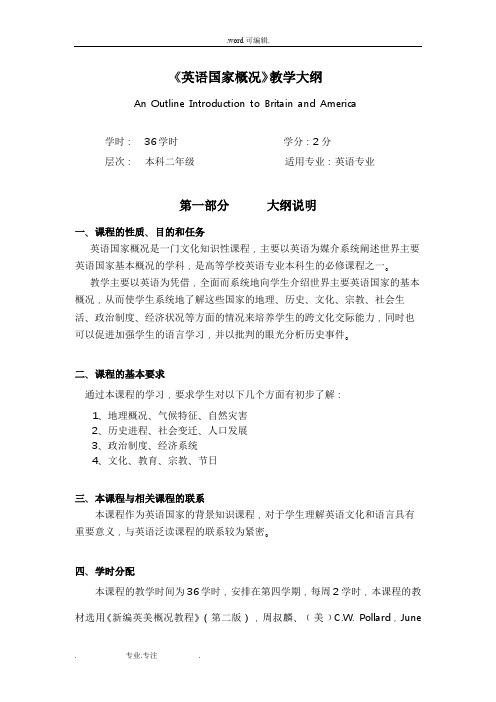
《英语国家概况》教学大纲An Outline Introduction to Britain and America学时:36学时学分:2分层次:本科二年级适用专业:英语专业第一部分大纲说明一、课程的性质、目的和任务英语国家概况是一门文化知识性课程,主要以英语为媒介系统阐述世界主要英语国家基本概况的学科,是高等学校英语专业本科生的必修课程之一。
教学主要以英语为凭借,全面而系统地向学生介绍世界主要英语国家的基本概况,从而使学生系统地了解这些国家的地理、历史、文化、宗教、社会生活、政治制度、经济状况等方面的情况来培养学生的跨文化交际能力,同时也可以促进加强学生的语言学习,并以批判的眼光分析历史事件。
二、课程的基本要求通过本课程的学习,要求学生对以下几个方面有初步了解:1、地理概况、气候特征、自然灾害2、历史进程、社会变迁、人口发展3、政治制度、经济系统4、文化、教育、宗教、节日三、本课程与相关课程的联系本课程作为英语国家的背景知识课程,对于学生理解英语文化和语言具有重要意义,与英语泛读课程的联系较为紧密。
四、学时分配本课程的教学时间为36学时,安排在第四学期,每周2学时,本课程的教材选用《新编英美概况教程》(第二版),周叔麟、﹝美﹞C.W. Pollard,JuneAlmes主编,北京大学出版社;并辅以英美重要文献资料的阅读和分析。
整个教学顺序安排如下:五、教材与参考书教材:《新编英美概况教程》(第二版),周叔麟,﹝美﹞C.W. Pollard,June Almes主编,北京大学出版社,2010年5月出版。
教学参考书:1.Davidson, James. Nation of Nations. McGraw Hill, 4th edition, 2006. 2. Grafton, John Edited. The Declaration of Independence and Other Great Documents of American History 1775-1865. Dover Publications, Inc. 2000.3. Zinn, Howard. A People's History of the United States: 1492 to Present. Harper Perennial Modern Classics, August 2, 2005.4.来安方编著,张克定校订,《英美概况》(新增订本),郑州:河南人民出版社,2007年8月.5.马丁·吉尔伯特著,王玉菡译,《美国历史地图》,北京:中国青年出版社,2009年.6.马丁·吉尔伯特著,王玉菡译,《英国历史地图》,北京:中国青年出版社,2009年.7.余志远主编《英语国家概况》,北京:外语教育与研究出版社,2000年.课外阅读部分:英国部分:《大宪章》、《权利法案》美国部分:《独立宣言》、《美国宪法》、《人权法案》、《解放黑人奴隶宣言》六、教学方法与手段建议该课程的教学应遵循以下原则:6.1系统性原则:以系统思想为依据,将整个历史部分的教学过程视为一项系统工程,采用系统方法和手段,对教学过程的各个环节以及与教学相关的因素进行系统分析,对教学的内容和程序予以系统设计,以求在现有的条件下达到最佳教学效果。
英语国家概况

英语国家概况自学指导书江苏技术师范学院自学进度表总学时:80面授学时:24 自学学时:56函授英语国家概况自学指导书一、教材说明本函授课程使用教材为高等教育出版社出版,朱永涛主编的《英语国家社会与文化入门》(The Society and Culture of Major English-Speaking Countries: An Introduction) 上册。
《英语国家社会与文化入门》是一套关于主要英语国家(英国、澳大利亚和新西兰)的社会与文化背景的教科书,旨在帮助英语专业学生和英语自学者了解这些国家的社会与文化概貌,如地理、历史、政治、经济、社会生活和文化传统等方面的基本知识。
同时,通过课文的学习和各种练习的实践,达到提高英语水平的目的。
本书在课文的编写及练习的设计上力图符合中国学生的具体情况,根据中国学生的实际需要对难点作了精心注释,并设计了方便学生学习的练习。
其次,为了帮助学生理解课文,掌握英语,吸取知识,注释部分尽量做到详细、实用,力争起到教师课堂引导的作用。
注释的内容包括重大事件和人物的历史背景、典故、语言难点或学生不容易理解的地方等。
每课编有重点内容提示(Focal Points),以助于学生掌握课文的组织结构和中心思想。
每课课文后都设计了多项选择题、填空题及解释题,这些练习不仅可以帮助学生记忆各种信息,巩固和提高文化和语言知识,还可以帮助学生复习、归纳所学内容。
书后附有练习题的答案,供学习者参考。
此外,每章都编有思考题,供学生进行口语练习或用英语开展跨文化比较讨论时使用。
二、教学及自学内容具体内容如下:The United Kingdom of Great Britain andNorthern IrelandIntroduction: The United KingdomFocal Points:--a complicated country with a complicated name--the effects of its imperial past--a member of the European Union--a multiracial society--remarkable class, regional and economic differences--a significant role of LondonQuestions for Thought:1.What was the British Empire? What do you know about it? In whatway is the “Empire” still felt in Britain and in the international field?2.Why does the author say that it is not possible to sum up the Britishpeople with a few simple phrases?Chapter 1 Great BritainFocal Points:--a cultural and economic dominance of England--invasion from the Roman empire--settlement of the Anglo-Saxons--King Arthur--Vikings from Scandinavia--William the Conqueror--the legend of Robin Hood--Parliament’s dominance over the throne--physical features of Scotland--a cultural division between highland and lowland--the Battle of Bannockburn--independence of Scotland for 300 years--Union with England in 1707--a strong Scottish identity--a brief introduction of Wales--a history of invasions--Wales’ unification with the UK--campaigns for independenceQuestions for Thought:1.“British history has been a history of invasion”. Please illustrate thispoint with the examples from the text. How did each of the invasions influence English culture?2.What are some general characteristics of Scotland? How did Scotlandbecome part of the union of Great Britain?3.Describe characteristics of Wales and Wales’unification with GreatBritain.4.Are there any differences between England, Scotland and Wales interms of cultural tradition?Chapter 2 Northern IrelandFocal Points:--population and physical features of Northern Ireland--economy of Northern Ireland--the Home Rule Bill--the Easter Rising of 1916--the Sinn Fein Party--the religious conflicts between the Irish and the British--a partition of Ireland in 1921--a Civil Rights Movement--the presence of British soldiers on Northern Ireland since 1969--IRA’s violence in the 1970s--Bloody Sunday--the collapse of the power-sharing--cooperation between the British and Irish governments--IRA’s refusal to hand over their weapons--future for Northern Ireland still in doubtQuestions for Thought:1.What are some of the factors in Irish and English history that affectsthe situation in Northern Ireland today?2.Different parties and groups in the United Kingdom have differentsolutions to the political problem in Northern Ireland. Please sum up their different attitudes.Chapter 3 The Government of the United KingdomFocal Points:--the monarchy--the parliament--the birth of the Prime Minister and Cabinet--the British government today--the Constitution--Parliament--the monarchy--the House of LordsQuestions for Thought:1.What are some of the characteristics of the British constitutionalmonarchy? How has the English monarchy evolved gradually to the present constitutional monarchy?2.How did the doctrine of the “divine right of kings”, according to theauthor, lead to the English Civil War? What do you know about the causes of the English Revolution in the 17th century?3.What is the history of English parliament? What role did theparliament play in the Civil War?4.Discuss the major characteristics and the main content of the Britishconstitution.5.What kind of institution is the House of Lords? What role does it playin British government?Chapter 4 PoliticsFocal Points:--general elections--the political parties: the Conservative party, the Labour party and the Liberal Democrats--recent political trends: economy with high inflation and low growth, poverty, welfare payment, unemployment--current issuesQuestions for Thought:1.Who can stand for election as an MP in the UK? Why are smallparties and independent candidates powerless in the election campaign for the formation of a government?2.What are some of the similarities and dissimilarities between the threebig parties in the UK?Chapter 5 The UK EconomyFocal Points:--absolute decline and relative decline of British economy--recent history of British economy--the current UK economy: three main sectors-“primary”industries, “secondary” industries and tertiary industries--the aerospace industryQuestions for Thought:1.What did the Conservative Party under Mrs. Margaret Thatcherpromise to do to the UK national economy in 1979? The word “reform”in the national economy was also popular when Mrs.Margaret Thatcher formed the government and decided to change the UK economy. What was her radical reform programme? Was the pragramme successful according to the author?2.What are the three main areas in national economies? Describe thedevelopment of each of them.Chapter 6 British LiteratureFocal Points:--early British literature concerned with Christianity: Beowulf, the Canterbury Tales by Geoffrey Chaucer, the stories of King Arthur and his knights--the development of drama in the Renaissance: Marlowe, William Shakespeare--characteristics of the Romance writers in the 19th century: the Brontes, Charles Dickens, Sir Walter Scott, Robert Louis Stevenson--characteristics of the 20th century literature: Modernism, Postmodernism, Joseph Conrad, Virginia Woolf, D.H. Lawrence, E.M. Foster, George Orwell, John FowlesQuestions for Thought:1.Why do you think Geoffrey Chaucer was so significant in EnglishLiterature?2.Why do you think that the legend of King Arthur was so popular inthe early writing of English Literature? Can you find a similar examples in early Chinese Literature?Chapter 7 Sports in BritainFocal Points:--football: the FA and the FA Cup--tennis: Wimbledon--cricket--golf--horse racing, hunting and equestrianism: the Grand National, the Royal Ascot, “hunt saboteurs”--fishingQuestions for Thought:What are some of the major differences and similarities between the British and Chinese attitudes towards sports? What are some of the changes that have taken place recently in the Chinese attitude towards sports? How do you account for these changes?Chapter 8 British Holidays and FestivalsFocal Points:--religious holidays:: Christmas, Boxing Day, Easter--national holidays: “Trooping the Colour”--holidays in the 4 nations: Bonfire Night(Guy Fawkes Night) in England, St. Patrick’s Day in Northern Ireland, Hogmanay and Halloween inScotland and eisteddfod in WalesQuestions for Thought:Christmas is the biggest and best-loved British holiday. How do the British celebrate this holiday? In what way does this holiday and the ways of celebration in Britain reflect western cultural traditions in general and British traditions in particular? What is the biggest and best-loved holiday in China? Are there any similarities or differences between the Chinese people celebrating the biggest and best-loved holiday and the British celebrating Christmas?Chapter 9 British Education SystemFocal Points:--the purpose of the British education system--the relationship between education and social class--the present education system: comprehensive schools, grammar schools, GCSE, GCE-A, GVVQs--higher education: old universities, open universitiesQuestions for Thought:1.What are the purposes of the British education system? Pleasecomment on these purposes. What are the main purposes of the Chinese education system? Are there any differences or similarities in the education of the two nations?2.What is the Open University in Britain? What do you think of thissystem?Chapter 10 British Society: Housing, Class and RaceFocal Points:--housing: four main types of British home, namely flats, terraced houses, the “semi” and detached houses--class system in the British society: upper middle-class and lower middle-class, the hereditary aristocracy--ethnic relations in BritainQuestions for Thought:1.Why does the author say that “the way the living arrangement of asociety as a whole are organized tells us something about that society”?how does the housing in Britain reflect British society? Do you think it is also true in China? Use the changes that have taken place in the housing in your hometown to support your points.2.What are the four main types of home in Britain? How do they reflectthe cost and status of homes? What are some of the major types of home in China?Chapter 11 British Foreign RelationsFocal Points:--Britain Then and Now: imperial prime, UN, end of the great British empire--foundations of Britain’s foreign policy--how foreign policy is made--Britain and international institutions: the permanent member of the UN Security Council, the member of the European Union, the member of the Commonwealth--special relationships with the US--British security and defense policy: a member of the nuclear “club”, NATO, the lead nation of Rapid Reaction CorpsQuestions for Thought:1.What are the foundations of Britain’s foreign policy?2.Why does the author think that Britain has the “the specialrelationship” with the United States? Does this relationship still exist?Chapter 12 British MediaFocal Points:--British newspapers: The Times, The Observer, The Guardian, The Telegraph, The News of the World, The Financial Times, the tabloids --broadcast media: television and radio, the BBC, the Independent Television CommissionQuestions for Thought:1.The author says that “ the media are central to British leisure culture”,why does the author say so? What are some of the similarities and differences in terms of function between the British media and the Chinese media?2.Is the British press free from the government control and censorship?What is the relationship between the British press and politics or business?AustraliaChapter 13 Land, People and HistoryFocal Points:--an outline: the flag, the Australian national anthem, Australia’s coat ofarms, Australia’s official language, Australia’s national day--the land: location and size, geography/geology, climate--the peoplelife in AustraliaAustralia as a multicultural society--historyaboriginal society before the European settlementthe British colonization of Australiaexploration of the land by white settlersthe expansion of the British settlementearly development of the colony’s economy/agriculture establishment of local government/authorities/legislatureformation of the Commonwealth of AustraliaQuestions for Thought:Why does the author say that Australia is a multicultural society? What are some of the similarities and dissimilarities between China and Australia in this respect?Chapter 14 The Political Life in AustraliaFocal Points:--states and territoriessix states: New South Wales, Victoria, Queensland, South Australia, Western Australia, Tasmaniathree internal territoriesthe external territories--governmentthree-tier system of government: the Australian Parliament(thelegislature) and Government; six state governments and their legislatures; about 900 local government bodies at the city, town, municipal and shire level--international relationsAustralia and the UNChanges in Australian foreign policyAustralia in the Asia-Pacific regionAustralia in the South Pacific regionAustralia and the Western countriesAustralia’s nuclear policiesQuestions for Thought:Can you point out some main differences between the Australian government system and the British government system?Chapter 15 The EconomyFocal Points:--an overviewchanges in Australia’s economy after WWIIprimary industry—rural and mining sectorssecondary and tertiary industries—strong growthoverall economic performance in the past 20 years--resources and energy: minerals and metals--trade--primary industrylimitations on agriculture developmentAustralia as the world’s major exporter agricultural products--manufacturing industrythe tertiary sectorBHPQuestions for Thought:The author believes that Australia has a dynamic economy. What accounts for this according to the author? Do you agree with the author? Do you think we can learn something from Australia’s economic development?Chapter 16 The Cultural and Social LifeFocal Points:--educationtwo main types of school: government and non-government schools compulsory schoolingprimary schoolingsecondary schoolingspecial educational programs for Aboriginal and Torres Strait Islander studentsspecial educational services for the disabled studentsmulticultural educationassistance from the federal governmentteacher’s qualificationpost-secondary education--the arts and literaturethe arts: distinctive Australian trendsthe literaturepoetry: Henry Kendall, Henry Lawsonfictional literature: Henry Lawson, Patrick Whitedrama: David Williamson--the mediaNewspapers and magazinesRadio and television--Healthprivate and public facilities of health care in Australiathe federal government’s role in health carehealth care for Aboriginal and Torres Strait Islander peoplethe Royal Flying Doctor Servicethe Red Cross Societythe fight against AIDSthe National Campaign Against Drugs--social servicessocial security program today: the age pension, the sole parent pensionQuestions for Thought:1.What are some of the features in the education system that arespecifically Australian?2.What is Medicare in Australia? Find out those particularly Australianhealth care practices.New ZealandChapter 17 Land, People and HistoryFocal Points:--geography, land and environmentgeography: North Island, South Islandthe weatherwildlife: unique flora and faunaenvironmental issues:the Resource Management Actozone depletion--the New ZealanderspopulationMaori SocietyPacific Island PeopleLanguageHuman rightsStandard of living--Maoritangatraditions: legends about MauiMaori SocietyEthnic relationsMaori language--historyfirst settlers of the Islandscoming of European Navigators and Settlersthe Gold Rushesthe relationship between Maori and Pakehathe Social Welfare Systemthe Post-war YearsQuestions for Thought:1.Discuss the Maori culture in New Zealand. Is it similar with theAboriginal culture in Australia?2.How has New Zealand avoided the air, water and land pollutionproblems of other industrialized countries?Chapter 18 Political System, Education and EconomyFocal Points:--governmentthe ConstitutionParliamentMixed member Proportional RepresentationThe CabinetPublic ServiceThe OmbudsmanLocal Government--education--agriculturehard-won reputation as the world’s largest farmtechnologyfarm managementcrops and horticulture--forestry & fishing--overseas tradeexports: dairy products, meat and wool; forestry exports; service marketsgovernment policy and prioritiesimportsQuestions for Thought:1.Why does the author say that New Zealand’s reputation as the world’slargest farm has been hard-won? In what way is New Zealand’s agriculture similar with Australia?2.The author says that New Zealand lives by trade. Is the authorjustified by saying this? Is it true in Australia and Britain?三、教学安排本课程共有80学时,其中面授24学时。
《英语国家》(1)(2)学习纲要
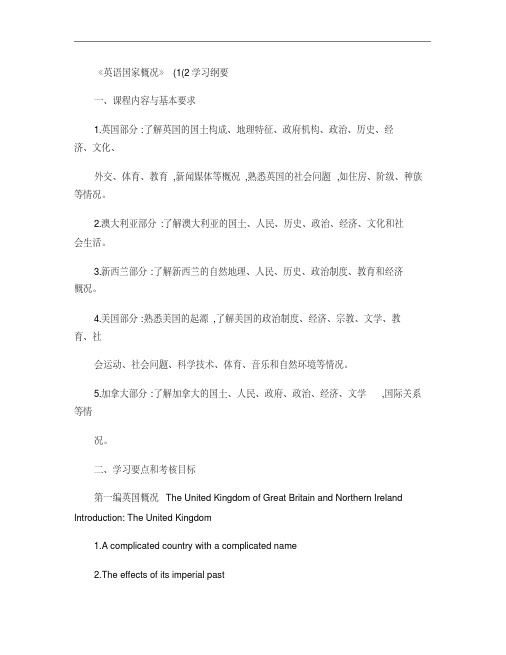
《英语国家概况》(1(2学习纲要一、课程内容与基本要求1.英国部分:了解英国的国土构成、地理特征、政府机构、政治、历史、经济、文化、外交、体育、教育,新闻媒体等概况,熟悉英国的社会问题,如住房、阶级、种族等情况。
2.澳大利亚部分:了解澳大利亚的国土、人民、历史、政治、经济、文化和社会生活。
3.新西兰部分:了解新西兰的自然地理、人民、历史、政治制度、教育和经济概况。
4.美国部分:熟悉美国的起源,了解美国的政治制度、经济、宗教、文学、教育、社会运动、社会问题、科学技术、体育、音乐和自然环境等情况。
5.加拿大部分:了解加拿大的国土、人民、政府、政治、经济、文学,国际关系等情况。
二、学习要点和考核目标第一编英国概况 The United Kingdom of Great Britain and Northern Ireland Introduction: The United Kingdom1.A complicated country with a complicated name2.The effects of its imperial past3.A member of the European Union4.A multiracial society5.Remarkable class, regional and economical differences6.Significant role of LondonChapter 1: Great Britain1.A cultural and economic dominance of England2.Invasion from the Roman empire3.Settlement of the Anglo-Saxons4.William the Conqueror5.Parliament’s dominance over the throne6.Physical features of Scotland7.A cultural division between highland and lowland8.The battle of Bannockburn9.Independence of Scotland for 300 years10.Union with England in 170711.A strong Scottish identity12.A brief introduction of Wales13.A history of invasions14.Wale’s unification with the UK15.Campaigns for independenceChapter 2: Northern Ireland1.Physical features of Northern Ireland2.Economy of Northern Ireland3.The Home Rule Bill4.The Easter Rising of 19165.The Sinn Fein Party6.The religious conflicts between the Irish and the British7.A partition of Ireland in 19218.Civil Rights Movement9.The presence of British soldiers on Northern Ireland since 196910.IRA’s vio lence in the 1970s11.Bloody Sunday12.The collapse of the power-sharing13.Cooperation between the British and Irish governments Chapter3: The Government of the United Kingdom1.King Egbert2.Divine right of kings3.The civil war4.Charles I5.Roundheads6.Magna Carta7.The Great Council8.William of Orange9.The Bill of Rights of 168910.The Cabinet11.The prime minister12.George I13.The Constitution14.The power and the functions of the Parliament15.The roles of the monarch16.The house of Lords17.Life peers18.The House of CommonsChapter 4: Politics1. The importance of general elections2. The formation of the government3. Vote of no confidence4. The electoral campaigns5. The procedure of general elections6. The Conservative party and the Labour party7. The Liberal Democrats8. The National Health Service9. Margaret Thatcher10. John Major11. Tony BlairChapter 5: The UK Economy1. The privatization in the 1980s2. The main sectors of the UK economy3. Primary industries4. Secondary industries5. Tertiary/service industries6. Agriculture7. Energy production8. The offshore oil industries9. The manufacturing industry10. The city of London11. The London Stock Exchange12. The aerospace industry13. ConcordeChapter 6: British Literature1. Early British literature concerned with Christianity2. Beowulf3. The Canterbury Tales by Geoffrey Chaucer4. The stories of King Arthur and his knights5. The development of drama in the Renaissance6. William Shakespear7. Characteristics of the Romance writers in the 19th century8. The Brontes9. Charles Dickens10. Sir Walter Scott11. Robert Louis Stevenson12. Characteristics of the twentieth century literature13. Modernism14. Postmodernism15. Joseph Conrad16. Virginia Woolf17. D.H. Lawrence18. E.M. Foster19. George Orwell20. John FowlesChapter 7: Sports in Britain1. Popular sports in Britain2. The FA and the FA Cup3. Wimbledon4. Equestrianism5. The Grand National6. The Royal Ascot7. Hunt saboteursChapter 8: British Holidays and Festivals1. Christmas and its traditions2. The Boxing Day and its traditions3. Easter4. Ramadan5. Trooping the Colour6. Bonfire Night (Guy Fawkes Night and the traditions7. Hogmanay8. Halloween and the traditionsChapter 9: British Education System1. The purpose of the British education system2. The relationship between education and social class3. The influence of the church on schooling4. Comprehensive school5. Grammar school6. The national Curriculum7. Public school8. Open UniversityChapter 10: British Society: Housing, Class and Race1. Owner-occupation2. Four main types of British home3. Class system in the British society4. Upper middle-class and lower middle-class5. The hereditary aristocracy6. Oxbridge7. Life peers8. Ethnic relations in BritainChapter 11: British Foreign Relations1. Active in setting up the United Nations2. Foreign policy influenced by its history and geopolitical traits3. A parliamentary democracy4. Relations with other countries and organizationsChapter 12: The British Media1. Popularity and functions of the media2. British main newspapers3. The tabloids4. The broadcast media第二编澳大利亚概况 Australia1. Land, people and history2. The political life3. Economy4. The cultural and social life第三编新西兰概况 New Zealand1. Land, people and history2. Political system, education and economy第四编美国概况 The United States of AmericaChapter 1: American Beginnings1. Two immigration movements to the Americas2. American Indians3. Discovery of America4. The heritage of the settlement of Virginia5. The influence of Puritanism on American culture6. Lord Baltimore and his feudal plan7. Quakerism8. The heritage of the Holy Experiment in American culture9. The causes and major leaders of the American Revolution10. The Declaration of IndependenceChapter 2: The Political System in the United States1. The Articles of Confederation2. The making of the US Constitution3. The three branches of the federal governments1. 4. Checks and balances5. The Bill of Rights6. Political partiesChapter 3: American Economy1. Samuel Slater2. Eli Whitney3. Industrial Revolution in America4. Corporation5. Service industries6. Stock7. Agribusiness8. Migrant workersChapter 4: Religion in the United States1. American history and religious liberty2. The US Constitution and religion3. Protestants and Catholics in the US4. Religious diversity5. Characteristics of American religious beliefs Chapter 5: American Literature1. Famous writers in the US and their major works2. Transcendentalists3. The naturalists4. The “Modern Movement” in poetry5. The “Lost Generation”6. The Harlem Renaissance7. The “Beat Generation”8. Black writers and women writersChapter 6: Education in the United States1. The goal of education2. Different educational laws for different states3. Several levels of schooling4. curricula for students5. The complex system of higher education6. Varieties of colleges and universities7. Trends in degree programs8. The Servicemen’s Readjustment Act9. Affirmative action programs10. nontraditional studentsChapter 7: Social Movements of the 1960s-in”1. Greensboro “sit2. The Civil Rights Movement3. Martin Luther King, jr.4. The Anti-war Movement5. Free Speech Movement6. The Counter Culture7. Women’s Liberation MovementChapter 8: Social Problems in the United States1. Racial problems2. The black “underclass”3. Poverty, drug abuse and crime4. The abuse of power by government and corporations Chapter 9: Technology in America1. American system of production2. John H Hill3. Cyrus H McCormick and mechanical reaper4. The Stevens5. Samuel F B Morse6. The Pony Express System7. Alexander Graham Bell8. Thomas Alva Edison9. Frederick Winslow Taylor10. Henry Ford11. Robert Hutchings Goddard12. Household inventions in mid-20th century13. Television and PC14. Use of nuclear energyChapter 10: Scenic America1. The Grand Canyon2. Yellowstone National Park3. Disneyland4. The National Monument5. The Gulf of Mexico6. The Everglades7. Niagara FallsChapter 11. Sports in America1. Super Bowl2. AFC3. 4. 5. 6. 7. NFC The National League and the American League Home run NBA East Division and West Division Chapter 12: Early American Jazz 1. Jazz music 2. New Orleans jazz 3. Louis Armstrong 4. Ragtime music 5. Count Basie 6. Boogie Woogie 第五编 1. 2. 3. 4. 5. 加拿大概况 Canada The country and its people The government and politics The Canadian economy Canadian literature International relations。
英语国家概况考试大纲

《英语国家概况》考试大纲课程性质和学习目的《英语国家概况》是高等教育自学考试英语专业基础科段(专科)的一门必考课程。
设置本课程是为了使英语专业专科学生了解主要英语国家的地理、历史、经济和政治等方面的概况;了解主要英语国家的文化传统、风俗习惯和社会生活的其他有关情况。
本课程是一门实用性很强的文化知识课。
学生通过阅读主要英语国家(英国和美国)的北京材料,一方面可以扩大知识面,另一方面也可以提高英语阅读能力。
有关说明和实施要求高等教育自学考试的教育形式是个人自学、社会助学和国家考试相结合。
根据这种教育形多,结合本课程的特点,现对有关的几个问题说明如下:一、自学考试大纲的目的和作用《英语国家概况自学考试大纲》是根据英语专业考试计划的要求,结合自学考试的特点而确定的。
其目的是对个人自学、社会助学和国家考试命题进行指导和规定。
《英语国家概况自学考试大纲》明确了课程学习的内容以及深广度,规定了自学考试的范围和标准。
因此,它是编写自学考试教材和辅导书的依据,是社会助学组织进行自学辅导的依据,是自学者学习教材、掌握课程知识范围和程度的依据,也是进行自学考试命题的依据。
二、自学考试大纲与教材的关系《英语国家概况自学考试大纲》是进行学习和考核的依据,《英语国家概况》教材用于学习并掌握课程知识的基本内容与范围,教材的内容是大纲所规定的课程知识和内容的扩展与发挥。
三、学习内容本课程教材为《英语国家概况》(全国高等教育自学考试指导委员会组编,余志远主编,外语教学与研究出版社,2005)。
四、考核目标为了使本课程的自学考试达到科学化、规范化的要求,本大纲规定了全书的考核目标。
明确考核目标,可使应考者进一步了解考试内容和要求,知识怎么学和怎么考,从而更有目的、有计划地学习教材;可使社会助学单位知道如何组织教学,并根据应考者的实际状况进行辅导,使之达到既定的要求;可使命题单位正确把握试题的广度、深度和难易程度。
五、命题原则1.本课程考试的命题,应根据大纲所规定的考核目标,确定考试范围和考核标准,不要扩大或缩小考试范围,也不要提高或降低考核标准。
《英语国家概况》教学大纲
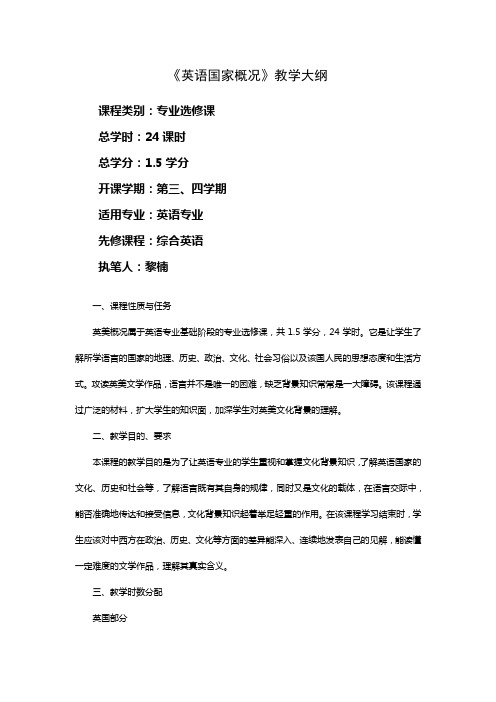
《英语国家概况》教学大纲课程类别:专业选修课总学时:24课时总学分:1.5学分开课学期:第三、四学期适用专业:英语专业先修课程:综合英语执笔人:黎楠一、课程性质与任务英美概况属于英语专业基础阶段的专业选修课,共1.5学分,24学时。
它是让学生了解所学语言的国家的地理、历史、政治、文化、社会习俗以及该国人民的思想态度和生活方式。
攻读英美文学作品,语言并不是唯一的困难,缺乏背景知识常常是一大障碍。
该课程通过广泛的材料,扩大学生的知识面,加深学生对英美文化背景的理解。
二、教学目的、要求本课程的教学目的是为了让英语专业的学生重视和掌握文化背景知识,了解英语国家的文化、历史和社会等,了解语言既有其自身的规律,同时又是文化的载体,在语言交际中,能否准确地传达和接受信息,文化背景知识起着举足轻重的作用。
在该课程学习结束时,学生应该对中西方在政治、历史、文化等方面的差异能深入、连续地发表自己的见解,能读懂一定难度的文学作品,理解其真实含义。
三、教学时数分配英国部分英国部分(上册)第一章:综述内容:从自然地理、自然资源、经济、人口和主要城市这几个方面讲述,使学生对英国有整体的认识课外作业:更多地了解英国的主要城市第二章:历史内容:本章从以下方面对英国历史进行讲述,英国的建立、中世纪的英国、封建制度的衰落、16世纪英国资产阶级的兴起、17世纪英国资产阶级革命、18世纪的英国工业革命、从自由资本主义到帝国主义、第一次世界大战与英国和第二次世界大战与英国课外作业:收集相关资料并掌握各部分知识点第三章:文化内容:从英国教育体系、传媒、体育、科学、文学以及历史文化古迹这几个方面详细介绍了英国的文化课外作业:重点比较英国与我国教育体系的相同和不同之处第四章:社会生活内容:本章重点讲述英国家庭和社会的习俗、礼仪,英国社会的工资和福利体系,以及英国的宗教信仰课外作业:充分了解英国的社会习俗第五章:政治制度内容:本章具体从以下几个方面进行讲述,英国的君主立宪政体,英国的宪法,英国的议会、内阁、首相与政府机构,以及英国的两党制和司法机构课外作业:就英国的政治制度写一篇1000字左右的论文第六章:文学内容:通过教学使学生掌握英国文学发展的几个重要历程和主要代表人物与代表作,以及英国文学其他方面的现状。
《英美概况》教学大纲
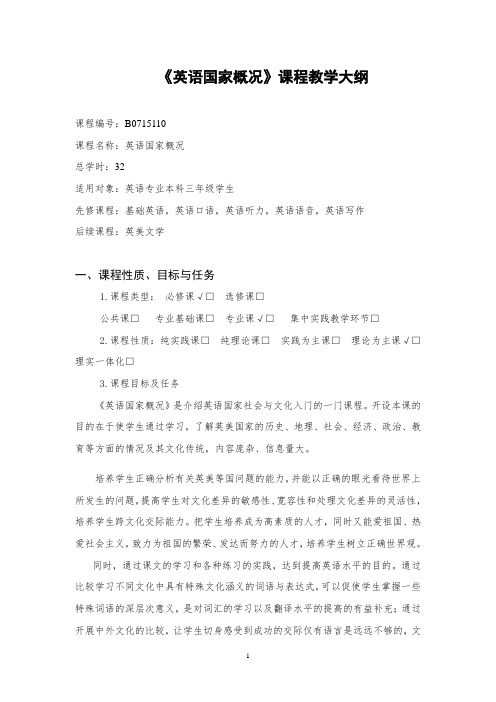
《英语国家概况》课程教学大纲课程编号:B0715110课程名称:英语国家概况总学时:32适用对象:英语专业本科三年级学生先修课程:基础英语,英语口语,英语听力,英语语音,英语写作后续课程:英美文学一、课程性质、目标与任务1.课程类型:必修课√□选修课□公共课□专业基础课□专业课√□集中实践教学环节□2.课程性质:纯实践课□纯理论课□实践为主课□理论为主课√□理实一体化□3.课程目标及任务《英语国家概况》是介绍英语国家社会与文化入门的一门课程。
开设本课的目的在于使学生通过学习,了解英美国家的历史、地理、社会、经济、政治、教育等方面的情况及其文化传统,内容庞杂、信息量大。
培养学生正确分析有关英美等国问题的能力,并能以正确的眼光看待世界上所发生的问题,提高学生对文化差异的敏感性、宽容性和处理文化差异的灵活性,培养学生跨文化交际能力。
把学生培养成为高素质的人才,同时又能爱祖国、热爱社会主义,致力为祖国的繁荣、发达而努力的人才,培养学生树立正确世界观。
同时,通过课文的学习和各种练习的实践,达到提高英语水平的目的。
通过比较学习不同文化中具有特殊文化涵义的词语与表达式,可以促使学生掌握一些特殊词语的深层次意义,是对词汇的学习以及翻译水平的提高的有益补充;通过开展中外文化的比较,让学生切身感受到成功的交际仅有语言是远远不够的,文化方面的因素有时所起的作用远远大于语言本身,必将为英语学习者成功地参与国际商务活动,更有效地进行国际合作与交流打下坚实的文化基础。
二、课时分配三、教学组织Unit One Introduction to the UK[教学目标与要求]:Understanding of:1 geographical features, climate2 characteristics of the UK3 history of the UK4distribution of the UK’s population[本章主要内容]:1 geographical features, climate2 characteristics of the UK3 history of the UK4distribution of the UK’s population[本章重点]:1 features of invasion of the UK2 the Great Empire, gentleman[本章难点]:Troubles in the Northern Ireland[本章思考题]:1.What is gentleman?2.The influences of the Great EmpireUnit Two The government of the UK[教学目标与要求]:Understanding of:1 Constitutional Monarchy2 British parliament and its functions3 British government[本章主要内容]:1 Constitutional Monarchy2 British parliament and its functions3 British government[本章重点]:1 Constitutional Monarchy2 British parliament and its functions[本章难点]:Constitutional Monarchy[本章思考题]:1.How long do you think the royal family can exist?Unit Three Politics, class and race[教学目标与要求]:Understanding of:1 understanding of the general election of the UK2 social class3 races[本章主要内容]:1 understanding of the general election of the UK2 social class3 races[本章重点]:1 the general election of the UK2 multiracial society[本章难点]:the general election of the UK[本章思考题]:1.The system of general elections and its influence in the worldUnit Four The UK economy[教学目标与要求]:Understanding of:1 understanding the position of the UK after the WW II2. the reason of the decline3 characteristics of British agriculture and industry[本章主要内容]:1 understanding the position of the UK after the WW II2. the reason of the decline3 characteristics of British agriculture and industry[本章重点]:1 the reasons for the decline2.the trends for the British economy[本章难点]:the reasons for the decline he general election of the UK[本章思考题]:1.The privatization and reform in the economic developmentUnit Five British literature[教学目标与要求]:Understanding of:1 the history of British literature2 writers3 schools4 divisions of literal periods[本章主要内容]:1 the history of British literature2 writers3 schools4 divisions of literal periods[本章重点]:1 the history of British literature2 well-known writers[本章难点]:divisions of literal periods[本章思考题]:1.Describe a writer/ a school/work you are most familiar with?Unit Six British education system[教学目标与要求]:Understanding of:1 the history of education2 education systems3 higher education[本章主要内容]:1 the history of education2 education systems3 higher education[本章重点]:1 the history of education2 education systems[本章难点]:higher education[本章思考题]:1.Compare British and Chinese higher educationUnit Seven British Foreign Relations[教学目标与要求]:Understanding of:1 UK foreign policies and their makings2 Britain and international institutions3 Britain and the United States[本章主要内容]:1 UK foreign policies and their makings2 Britain and international institutions3 Britain and the United States[本章重点]:1 UK foreign policies and their makings2 Britain and the United States[本章难点]:Britain and the United States[本章思考题]:1.The change of British image in international world from Iraqi warUnit Eight the British Media[教学目标与要求]:Understanding of:1 British newspapers2 broadcast media3 television media[本章主要内容]:1 British newspapers2 broadcast media3 television media[本章重点]:1 British newspapers2 broadcast media[本章难点]:British newspapers[本章思考题]:1.The functions of media in cultural acquisitionUnit Nine American beginnings[教学目标与要求]:Understanding of:1 a new land2 the settlement in Virginia3 Puritan New England4 Catholic Maryland5 Quaker Pennsylvania6 American revolution[本章主要内容]:1 a new land2 the settlement in Virginia3 Puritan New England4 Catholic Maryland5 Quaker Pennsylvania6 American revolution[本章重点]:1 A new land2 American revolution[本章难点]:American revolution[本章思考题]:1.How did modern development in Europe influence the settlement of North American colonies?Unit Ten Political system in the United States[教学目标与要求]:Understanding of :1 legislative branch2 executive branch3 Judicial branch4 political parties[本章主要内容]:1 legislative branch2 executive branch3 Judicial branch4 political parties[本章重点]:1 Checks and balance2 Political parties[本章难点]:checks and balance[本章思考题]:Compare the political systems between the UK and the USAUnit Eleven American economy[教学目标与要求]:understanding of:1.industry revolution2.free enterprise3 . American agriculture[本章主要内容]:1.industry revolution2.free enterprise3. American agriculture[本章重点]:1 free enterprise2. the roots of affluence[本章难点]:the roots of affluence[本章思考题]:The influences of American economy on the worldUnit Twelve Religion in the USA[教学目标与要求]:understanding of:1 religious liberty2. protestants in the USA3. Catholics in the USA[本章主要内容]:1 religious liberty2. protestants in the USA3. Catholics in the USA[本章重点]:1 religious liberty2 religious diversity[本章难点]:American character of religion[本章思考题]:The effects of religion on American culture and everyday lifeUnit Thirteen American literature[教学目标与要求]:Understanding of:1 the history of American literature2 writers3 schools4 divisions of literal periods[本章主要内容]:1 the history of American literature2 writers3 schools4 divisions of literal periods[本章重点]:1 the history of American literature2 well-known writers[本章难点]:divisions of literal periods[本章思考题]:Describe a writer/ a school/work you are most familiar with?Unit Fourteen Education system in the United States[教学目标与要求]:Understanding of:1 the history of education2 education systems3 higher education[本章主要内容]:1 the history of education2 education systems3 higher education[本章重点]:1 the history of education2 education systems[本章难点]:higher education[本章思考题]:1.Why American schools have more international students than any other countries?Unit Fifteen Social problems in the USA[教学目标与要求]:Understanding of:1 racial problems2 drug abuse3 crimes4.abuse of power by government and corporation[本章主要内容]:1 racial problems2 drug abuse3 crimes4.abuse of power by government and corporation[本章重点]:1 racial problems2 drug abuse[本章难点]:racial problems[本章思考题]:Why is it perceived as a major threat to American society?Unit Sixteen Post-WWII American foreign policy[教学目标与要求]:understanding of:1 the beginning of the cold war2 arm races3 the engagement and expansion[本章主要内容]:1 the beginning of the cold war2 arm races3 the engagement and expansion[本章重点]:1 the cold war2 the engagement and expansion[本章难点]:the cold war[本章思考题]:The current international relationships and the role America plays in it四、课程考核学生总评成绩取决于学生的出勤情况、课堂参与、学期论文、课后作业和期末考试成绩。
教学大纲

《英语国家概况(1)》课程教学大纲第一部分课程教学基本要求英语国家概况(1)是有关英语国家(英国、爱尔兰和澳大利亚)的社会与文化背景的课程。
旨在帮助学生了解这些国家的社会与文化概况,如地理,历史,政治,经济,教育体制, 社会生活和文化传统等方面的基本知识。
同时,通过课文的学习和各种练习的实践,帮助记忆各种信息,巩固和提高文化和语言高知识,帮助复习、归纳所学内容,达到提高英语水平的目的。
第二部分各章教学内容及教学要求英国部分:第一单元英国简介I(A Brief Introduction to the United Kingdom)(建议2课时)一、教学目的通过本单元学习,掌握英国的全称,它的几个构成部分,不列颠被征服的历史,并对其4个组成部分的历史、地理、现状等有个简要了解。
二、教学内容与要求1. 1. A complicated country with a complicated name (复杂的名称,复杂的国家)2. 2. The effects of its imperial past (帝国主义历史的影响)3. 3. A multiracial society (多种族的社会)4. 4. Remarkable class, regional and economic differences (显著的阶级、地域和经济差异)5. 5. The significant role of London (伦敦的重要地位)6. 6. Cultural and economic dominance of England (英格兰的在文化和经济上的统治地位)7. 7. The conquest of Britain (对不列颠的征服)8. 8. Parliament’s dominance over the throne(议会成为凌驾于王室权力之上的统治机构)9. 9. Physical features of Scotland (苏格兰的地理特征)10. 10.Cultural division between highland and lowland (苏格兰高地和低地之间的文化区分)11. 11.The Battle of Bannockburn (班诺克本战役)12. 12.Union with England in 1707 {1707年(苏格兰)与英格兰合并}13. 13.Strong Scottish identity (仍具有很浓的苏格兰特色)14. 14.Brief introduction of Wales (对威尔士的简要介绍)15. 15.Campaigns for independence of UK (威尔士的独立运动)第二单元英国简介II-北爱尔兰(Northern Ireland)(建议2课时)一、教学目的通过本单元学习,掌握作为英国的一部分的北爱尔兰的地理特征、政治局势、武装冲突等方面的知识,了解其历史和经济状况等。
自考“英语国家概况”大纲详解(1)

英国概况 1. Land and People 国⼟与⼈民 Different names for Britain and its parts 英国的不同名称及其区域 正式名称:⼤不列颠及北爱尔兰联合王国。
简称:联合王国,或UK.⾸都伦敦。
它包括不列颠岛和北爱尔兰。
不列颠诸岛:包括不列颠岛,爱尔兰岛和⼏百个⼩岛。
爱尔兰岛:岛的北部地区,即北爱尔兰属于联合王国;岛的南部地区,称为爱尔兰共和国或爱尔兰,1949年独⽴,⾸都是都柏林。
三个政治区域:英格兰,苏格兰,威尔⼠。
由于帝国主义扩张政策,英国成为⼀个帝国。
两次世界⼤战后,其殖民地不断独⽴,⼤英帝国逐渐消失,1931年由英联邦取代。
英联邦:是由原英国殖民地组成的⼀个⾃由联合体,各独⽴成员国间,根据贸易协议实⾏经济合作。
英联邦没有特别的权⼒,⽬前有50个成员国。
2. Origins of the Nation 英国的起源 Arrival and settlement of the Celts 凯尔特⼈的到来和迁居 ⾃公元前700年不断迁⼊,来⾃东欧及中欧,即现在的法国,⽐利时和德国南部。
三次⼊侵⾼潮: 第⼀次是公元前600年,盖尔⼈。
第⼆次是公元前400年,布⽴吞(不列颠)⼈。
第三次是公元前150年,贝尔盖⼈。
强⼤的酋长卡西弗洛诺斯,莎⼠⽐亚剧本中的⾟⽩林。
技艺:农耕,沼泽地排⽔,修建房屋,铁匠。
后裔:⼭地苏格兰⼈,爱尔兰⼈,威尔⼠⼈。
语⾔:是威尔⼠语和盖尔语的基础。
宗教:德鲁伊德教。
德鲁伊德指智者,占星家和占⼘者。
采⽤活⼈祭祀。
Basis of modern English race: the Anglo-Saxons 现代英格兰民族的基础:盎格鲁——撒克逊⼈ 三⽀⽇尔曼(条顿)部落的⼊侵: 朱特⼈:来⾃朱特兰岛(现丹麦南部)。
酋长亨及斯特和霍塞,帮助肯特国王伏泰根驱逐⽪克特⼈和苏格兰⼈后,转⽽攻击伏泰根,最终亨及斯特成为肯特国王。
- 1、下载文档前请自行甄别文档内容的完整性,平台不提供额外的编辑、内容补充、找答案等附加服务。
- 2、"仅部分预览"的文档,不可在线预览部分如存在完整性等问题,可反馈申请退款(可完整预览的文档不适用该条件!)。
- 3、如文档侵犯您的权益,请联系客服反馈,我们会尽快为您处理(人工客服工作时间:9:00-18:30)。
附:自学考试《英语国家概况》自学考试教材目录(课程代码:0522)Part one The United Kingdom of Great Britain and Northern Ireland Chapter1Land and PeopleChapter2The Origins of a Nation(5000BC-AD1066)Chapter3The Shaping of the Nation(1066——1381)Chapter4Transition tO the Modern Age(1455——1688)Chapter5The Rise and Fall of the British Empire(1688——1990)Chapter6The EconomyChapter7Government and AdministrationChapter8Justice and the LawChapter9Social AffairsChapter10Cultural AffairsPart Two The Republic of IrelandChapter11Geography and HistoryChapter12Ireland TodayPart Three The United States of AmericaChapter13GeographyChapter14Population.Race and Ethnic GroupsChapter15American History(I)(1600——1900)Chapter16American History(II)(1900-1945)Chapter17American History(III)America in Post Era(1945-1980s)Chapter18The EconomyChapter19Political InstitutionsChapter20EducationChapter21Literature.Architecture and MusicChapter22Holidays and FestivalsPart Four CanadaChapter23Geography and HistoryChapter24The EconomyChapter25Government and PoliticsChapter26Society and CulturePart Five AustraliaChapter27Land and PeopleChapter28Australian History(I)Australia to FederationChapter29Australian History(II)Australia Since FederationChapter30The EconomyChapter31Government and PoliticsChapter32Society and CulturePart Six New ZealandChapter33The Making of New ZealandChapter34New Zealand Today第一部分英国概况第一章国土和人民第二章英国民族起源(5000BC~AD1066)第三章民族的形成(1066~1381)第四章向现代过渡时期的英国(1455~1688)第五章大英帝国的兴衰(1688~1990)第六章经济第七章英国政府机构第八章法律与司法机构第九章英国社会第十章英国文化第二部分爱尔兰概况第十一章爱尔兰地理与历史第十二章今日爱尔兰第三部分美国概况第十三章美国地理第十四章人口、种族和种族集团第十五章美国历史(I)(1600~1900)第十六章美国历史(II)(1900~1945)第十七章美国历史(III)二次大战后的美国(1945-1980S)第十八章美国经济第十九章政治体制第二十章教育第二十一章文学、建筑和音乐第二十二章假日和节日第四部分加拿大概况第二十三章加拿大地理与历史第二十四章加拿大经济第二十五章加拿大政府与政治第二十六章加拿大的社会与文化第五部分澳大利亚概况第二十七章土地与人民第二十八章澳大利亚联邦成立之前的历史第二十九章澳大利亚联邦成立以来的历史第三十章澳大利亚经济第三十一章澳大利亚政府与政治制度第三十二章澳大利亚社会与文化第六部分新西兰概况第三十三章新西兰地理与历史第三十四章今日新西兰附件:《英语国家概况自学考试大纲》的考核目标Part One The United Kingdom of Great Britain and Northern Ireland Chapter1Land and PeopleI.Different Names for Britain and its PartsChapter2The Origins of a NationI.Early Settlers3.The CeltsII.Roman BritainIII.The Anglo-SaxonsⅣ.The Viking and Danish InvasionsV.The Norman ConquestChapter3The Shaping of the NationⅠ.Norman Rule1.William’s RuleⅡ.The Great Charter and the Beginning of Parliament1.The Great CharterⅢ.The Hundred Years’War with FranceⅣ.The Black Death and the Peasant UprisingChapter4Transition to the Modern AgeⅠ.Transition to the Modern AgeⅡ.The English ReformationⅢ.Elizabeth I1.Elizabeth and Parliament2.Elizabeth’s Religious Reform3.Elizabeth’s Foreign PolicyⅣ.The English RenaissanceVII.The Civil WarsVIII.The CommonwealthIX.The Restoration and the Glorious Revolution of1688Chapter5The Rise and Fall of the British EmpireⅠ.Whigs and ToriesⅡ.Agricultural Changes in the Late18th CenturyⅢ.The Industrial RevolutionⅣ.The Chartist MovementVII.Twentieth Century1.Britain and the First World War3.Britain and the Second World War4.Postwar BritainChapter7Government and AdministrationⅠ.The MonarchyⅡ.Parliament1.The House of Lords2.The House of CommonsⅢ.The Cabinet and MinistryⅣ.The Privy CouncilChapter8Justice and the LawIV.The JudiciaryV.PoliceChapter9Social AffairsⅠ.Health and Social Services1.The National Health ServiceⅢ.Religion1.Established churchesⅣ.Festivals and Public Holidays1.Christian festivals2.Other festivals3.Public holidaysChapter10Cultural AffairsⅠ.Education3.Higher educationⅡ.The Media1.NewspapersⅢ.SportsⅣ.The Arts3.DramaPart Two The Republic of Ireland Chapter11Geography and HistoryI.Geographical FeaturesII.Climate and WeatherIII.Population and ReligionIV.Historical backgroundPart Three The United States of America Chapter14Population,Race and Ethnic GroupsI.IntroductionIV.Racial and Ethnic Minorities1.BlacksChapter15American History(I)Ⅰ.Discovery of the New WorldⅡ.The Colonial PeriodⅢ.The War of IndependenceⅣ.A New Form of GovernmentⅥ.Territorial Expansion and Westward MovementⅦ.The Civil WarⅧ.Rapid Growth of Capitalism after the Civil WarChapter16American History(II)Ⅰ.Economic DevelopmentⅡ.ProgressivismⅢ.World War I and the United StatesⅣ.The United States in the1920sⅤ.The Great Depression and the New DealⅥ.World War II and the United StatesChapter17American History(III)Ⅰ.The Origins of the Cold WarⅡ.The Truman Doctrine and the Marshall Plan V.McCarthyismVII.American Society During the Postwar Boom:1945-1960s VIII.The Cuban Missile CrisisIX.The Vietnam WarX.United States’Relations with ChinaXII.Watergate ScandalChapter18The Economy(Two paragraphs)Ⅰ.The Economic System of the United StatesV.Foreign TradeVI.Problems in the U.S.EconomyChapter19Political InstitutionsⅠ.The U.S.Constitution1.The Federal system2.Separation of powers:checks and balances3.Provisions for amendmentⅡ.The Executive Branch1.The Presidency2.Presidential PowersⅢ.The Legislative Branch2.Powers of the House and Senate3.Officers of the Congress4.Functions of the CongressⅤ.Political Parties(two-party system)Chapter20EducationⅠ.Characteristics of American EducationⅡ.Elementary and Secondary EducationⅢ.Higher EducationⅤ.Education ReformsChapter21Literature,Architecture and MusicⅠ.American Literature1.Washington Irving2.Emerson and Hawthorne3.Mark Twain4.Whitman and Dickinson5.Theodore Dreiser6.T.S.Eliot7.Ernest Hemingway8.Hughes and WrightChapter22Holidays and FestivalsⅠ.New Year’s DayIV.Valentine’s DayVI.Easter DayVIII.Independence DayIX.HalloweenXI.Thanksgiving DayⅩII.Christmas DayPart Four Canada Chapter23Geography and HistoryⅠ.Geographic Features4.Geographic regionsⅡ.The making of Canada1.The European discovery3.Self-government and Confederation4.The Canadian nationChapter26Society and CultureI.Canadian Society1.Population2.Immigration3.Bilingualism4.MulticulturalismPart Five Australia Chapter27Land and peopleⅠ.The Geographical Structure1.The Great Western Plateau2.The Eastern Highlands3.The Central Eastern LowlandsⅡ.Climate3.Causes and effects of the hot and dry climate Ⅳ.People1.Population2.Population density and distributionⅤ.Australia’s Built Environment1.Sprawling cities2.Rural areasⅥ.Political Divisions1.New South Wales2.Victoria3.Queensland4.South Australia5.West Australia6.TasmaniaChapter32Society and CultureIV.Australian Culture1.Aboriginal culture2.Modern Australian culturePart Six New Zealand Chapter33The Making of New ZealandⅠ.GeographyⅡ.ClimateⅢ.Plants and AnimalsⅣ.Historical Background2.The Treaty of Waitangi1840VI.Maoritanga5.Race relations《<英语国家概况>自考辅导》目录(配合《英语国家概况》余志远,外语教学与研究出版社2005版)Part One The United Kingdom of Great Britain and North IrelandChapter1Land and People(英国的国土与人民)Chapter2The origins of the Nation(国家的起源)Chapter3The Shaping of the Nation(英国的形式)Chapter4Transition to the Modern Age(向现代过度的英国)Chapter5The Rise and Fall of the British Empire(英帝国的兴衰)Chapter6The Economy(英国经济)Chapter7Government and Administration(英国政府机构)Chapter8Justice and the Law(法律和司法机构)Chapter9Social Affairs(社会事务)Chapter10Cultural Affairs(文化事务)Part Two The Republic of IrelandThe Republic of Ireland(爱尔兰共和国)Part Three United States of AmericaChapter1A Survey of American Natural Circumstances and Geography(美国的自然环境和地理概况)Chapter2People and Ethnic Groups(人口和名族)Chapter3American History(Ⅰ)(1600-1900)(美国历史)Chapter4American History(Ⅱ)(1900-1945)(美国历史)Chapter5American History(Ⅲ)(1945-1980s’)(美国历史)Chapter6American Literature(美国文学)Chapter7American Economy(美国经济)Chapter8American Politics(美国政治)Chapter9American Education(教育)Chapter10American Music,Architecture and Newspaper(音乐、建筑和报纸)Chapter11Holidays and Festivals(美国的节假日)Part Four CanadaChapter1The History of Chanada(加拿大的历史)Chapter2Canadian Geography(加拿大地理)Chapter3The Economy(经济)Chapter4Government and Politics(政府和政治)Chapter5Society and Culture(社会与文化)Part Five AustraliaChapter1Australia”s Land and People(澳大利亚的国土与人口)Chapter2Australian History(澳大利亚历史)Chapter3Australian Economy(澳大利亚经济)Chapter4Polotical System(澳大利亚政治体制)Chapter5Society and Culture(社会与文化)Part Six New ZealandChapter1The making of New of New Zealand(地理与历史)Chapter2New Zealand Today(今日新新西兰)。
